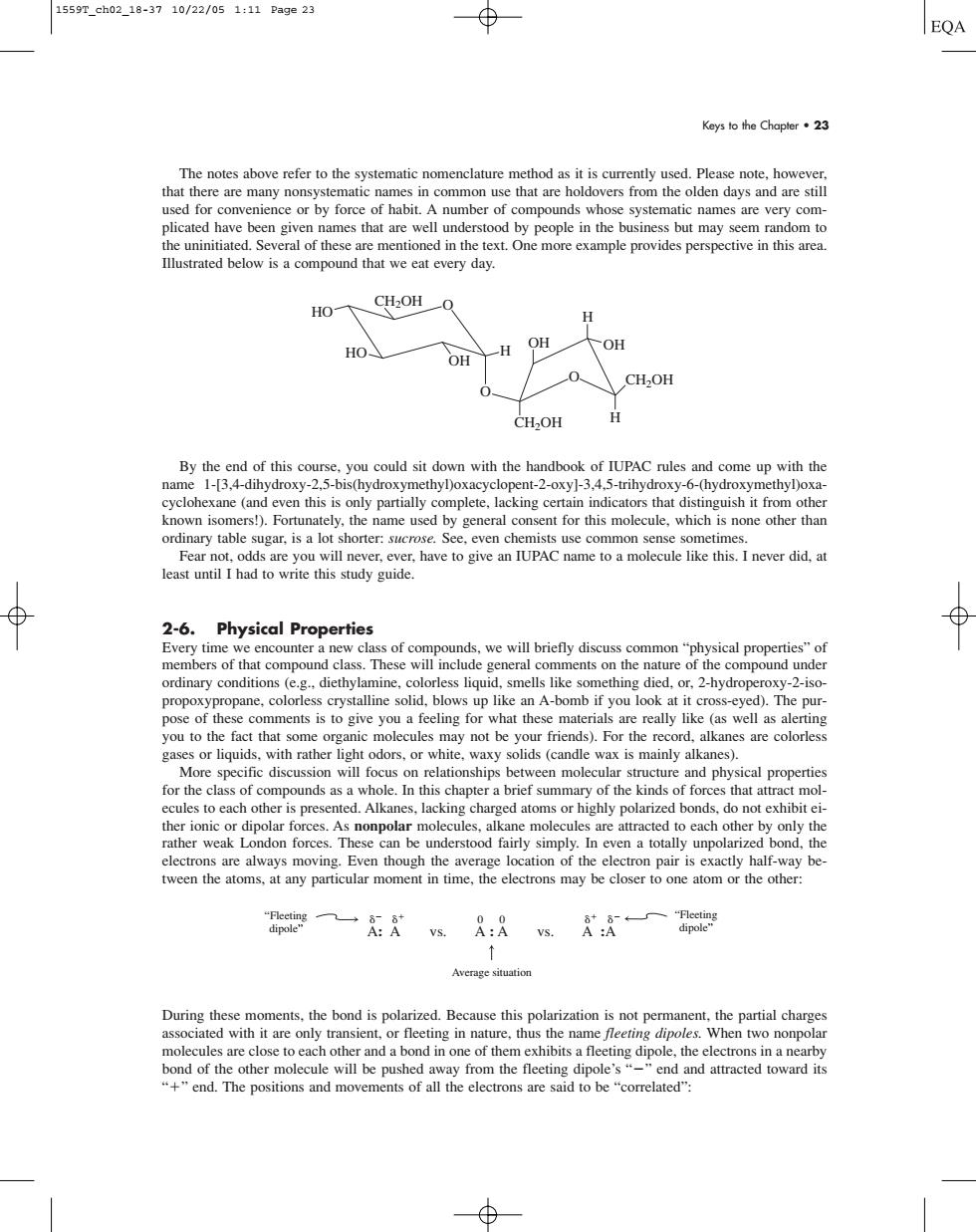正在加载图片...

1559T_ch02_18-3710/22/051:11Page23 EQA Keys to the Chapler·23 used for convenience or by force of habit.A number of compounds whose systematic names are very com the uninitiated.Several vprovides perspectiven en g L of th n the HO- CH2OH Q H H OH 个OH 0 0 CH-OH end of this ould sit do with the handbook of rule vith the cyclohexane (and even this is only partially complete.lacking certain indicators that dist nguish it from othe is a lo the name used by genera which isnone other thar Fear not,oddsare you will never,ever,have to give IUPAC name toa molecule like this.Inever did.at least until I had to write this study guide 2-6.Physical Properties Every time we encounter ordinary conditions (e.g..diethylamine,colorless liquid,smells like something died.or,2-hydroperoxy-2-iso propoxypropane,colorless crystalline soli blows up like n A-bomb if you look at it )The pur gases or liquids.with rather light odors.or white.waxy solids (candle wax is mainly alkanes) ore specinc discuss on wIl nd phy or ccules is presented.Alkanes,lacking charged atoms or highly polarized bonds,do are attracte clectrons are always moving.Even though the average location of the electron pair is exactly half- icular moment in time te slects my c AA:AsAA一 Average situation During these moments.the bond is polarized.Because this polarization is not permanent.the partial charges e,thus other end and attracted toward its end.The positions and movements of all the electrons are said to be"correlated" Keys to the Chapter • 23 The notes above refer to the systematic nomenclature method as it is currently used. Please note, however, that there are many nonsystematic names in common use that are holdovers from the olden days and are still used for convenience or by force of habit. A number of compounds whose systematic names are very complicated have been given names that are well understood by people in the business but may seem random to the uninitiated. Several of these are mentioned in the text. One more example provides perspective in this area. Illustrated below is a compound that we eat every day. By the end of this course, you could sit down with the handbook of IUPAC rules and come up with the name 1-[3,4-dihydroxy-2,5-bis(hydroxymethyl)oxacyclopent-2-oxy]-3,4,5-trihydroxy-6-(hydroxymethyl)oxacyclohexane (and even this is only partially complete, lacking certain indicators that distinguish it from other known isomers!). Fortunately, the name used by general consent for this molecule, which is none other than ordinary table sugar, is a lot shorter: sucrose. See, even chemists use common sense sometimes. Fear not, odds are you will never, ever, have to give an IUPAC name to a molecule like this. I never did, at least until I had to write this study guide. 2-6. Physical Properties Every time we encounter a new class of compounds, we will briefly discuss common “physical properties” of members of that compound class. These will include general comments on the nature of the compound under ordinary conditions (e.g., diethylamine, colorless liquid, smells like something died, or, 2-hydroperoxy-2-isopropoxypropane, colorless crystalline solid, blows up like an A-bomb if you look at it cross-eyed). The purpose of these comments is to give you a feeling for what these materials are really like (as well as alerting you to the fact that some organic molecules may not be your friends). For the record, alkanes are colorless gases or liquids, with rather light odors, or white, waxy solids (candle wax is mainly alkanes). More specific discussion will focus on relationships between molecular structure and physical properties for the class of compounds as a whole. In this chapter a brief summary of the kinds of forces that attract molecules to each other is presented. Alkanes, lacking charged atoms or highly polarized bonds, do not exhibit either ionic or dipolar forces. As nonpolar molecules, alkane molecules are attracted to each other by only the rather weak London forces. These can be understood fairly simply. In even a totally unpolarized bond, the electrons are always moving. Even though the average location of the electron pair is exactly half-way between the atoms, at any particular moment in time, the electrons may be closer to one atom or the other: During these moments, the bond is polarized. Because this polarization is not permanent, the partial charges associated with it are only transient, or fleeting in nature, thus the name fleeting dipoles. When two nonpolar molecules are close to each other and a bond in one of them exhibits a fleeting dipole, the electrons in a nearby bond of the other molecule will be pushed away from the fleeting dipole’s “” end and attracted toward its “” end. The positions and movements of all the electrons are said to be “correlated”: A: A A vs. vs. A : A :A “Fleeting dipole” “Fleeting dipole” Average situation 0 0 HO HO O O O OH OH OH H H H CH2OH CH2OH CH2OH 1559T_ch02_18-37 10/22/05 1:11 Page 23